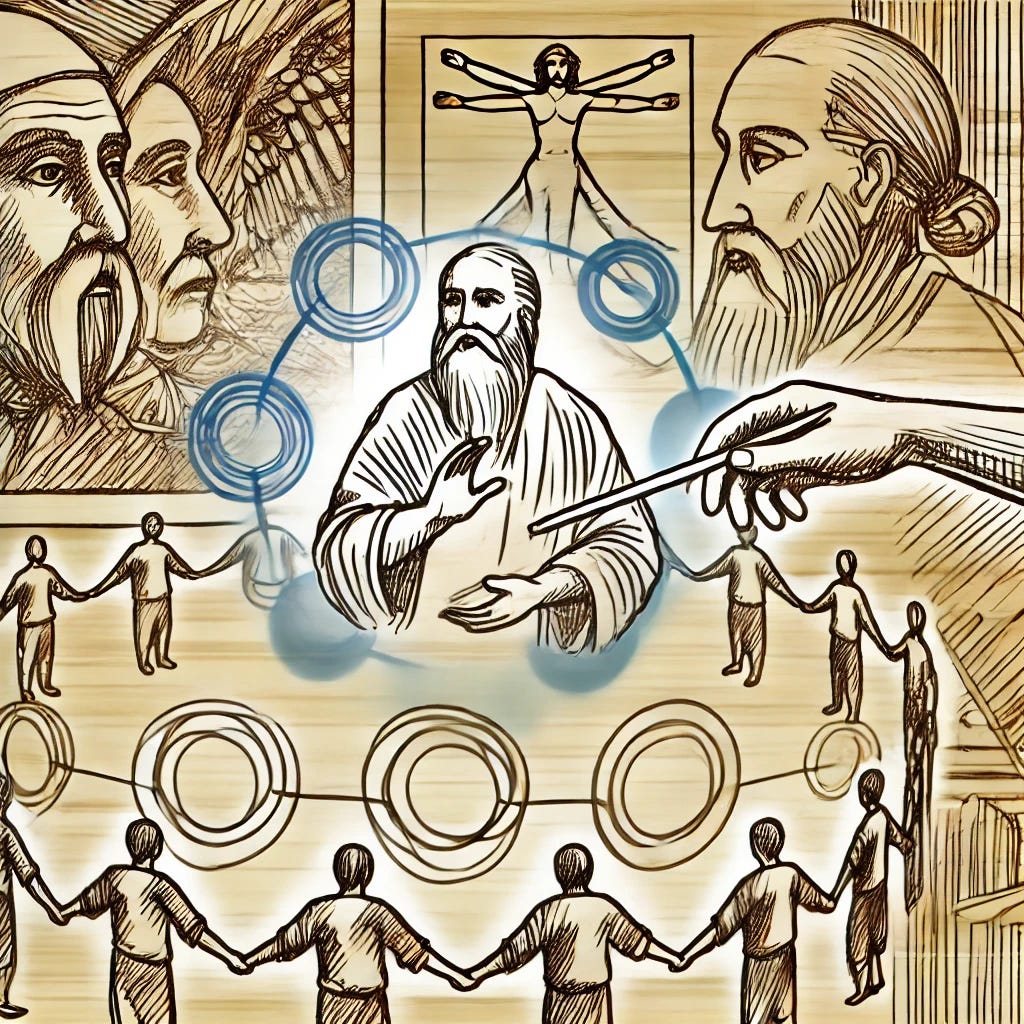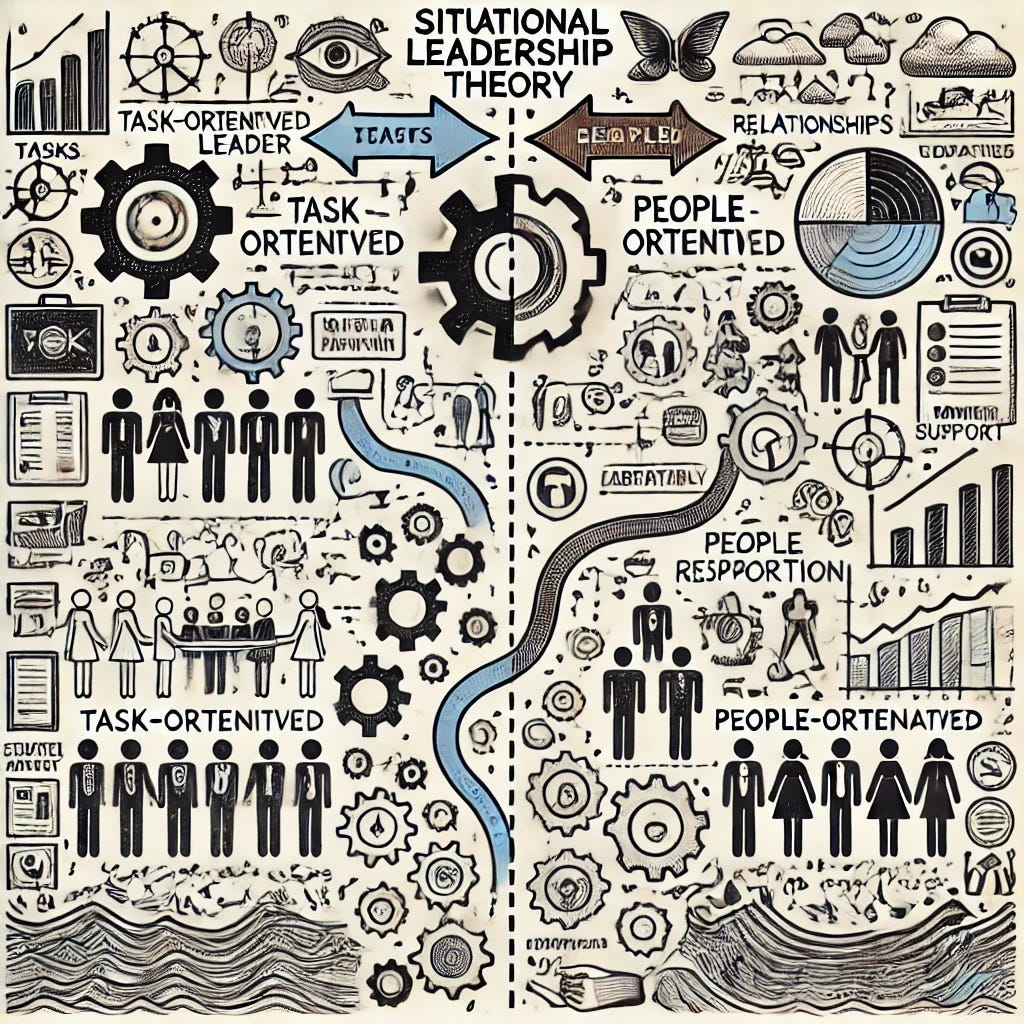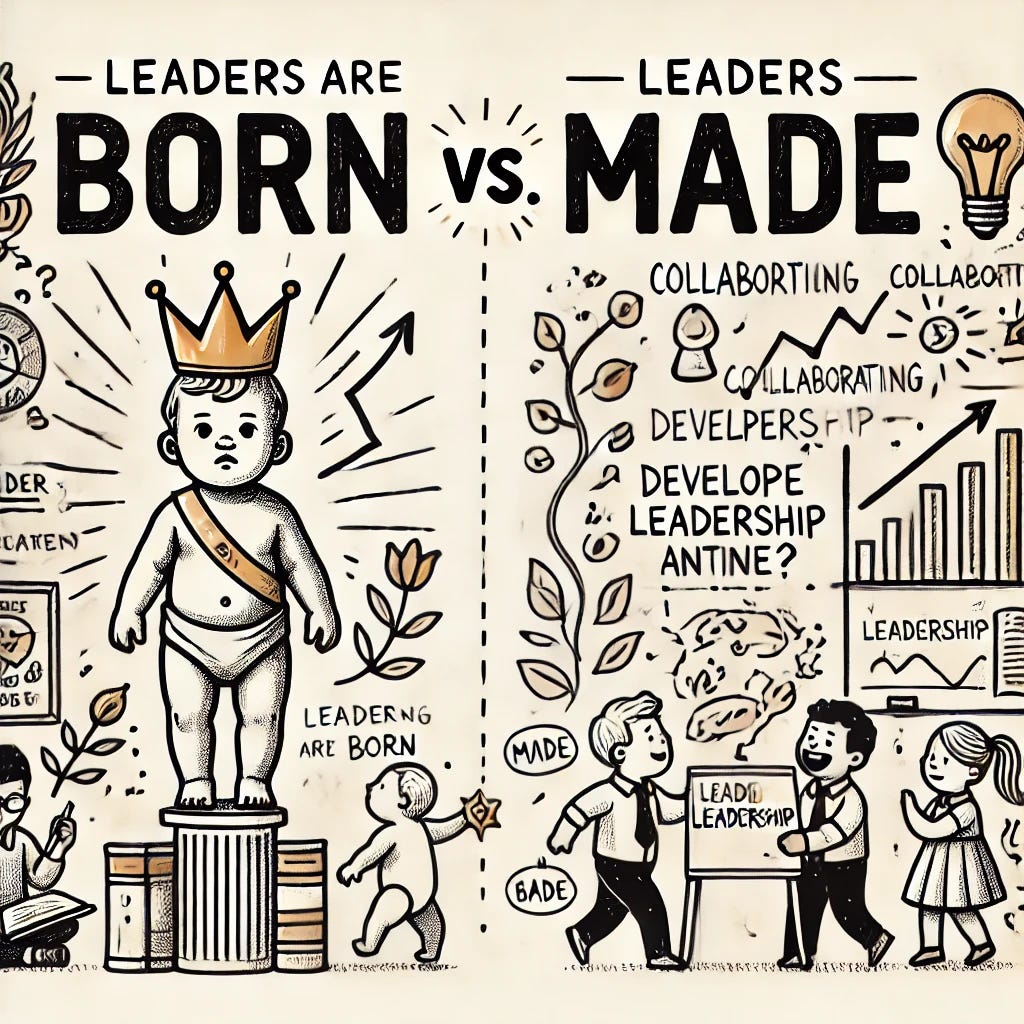🧗 Navigating Leadership: Theories, Examples, and Modern Corporate Challenges
OIJ (#14) A deep dive into leadership practices and their organizational effects
My dear fellow Hermits 👋
Welcome back to 🧙♂️ The Hermit 🧙♂️
ICYMI:
💼 The Hermit Portfolio: September Update
📈 Investment Thesis: Lazydays (mini write-up)
🧗 Our Investing Journey: Unnatural Monopolies
If you haven’t yet, subscribe to get access to this post, and every new post
Preliminary note
Here’s another post that adopts a completely different approach to learning about investing. This one leans more towards the academic side, drawing heavily from my readings and experiences back in 2018 while living and working abroad in Tokyo, Japan.
Let me share a glimpse of the beauty with you - a short clip of the Sakura (さくら), or cherry blossoms, captured along the scenic Meguro River in Tokyo.
If you enjoy this type of content, please let me know by leaving a ❤️ and a comment
Executive Summary
This essay explores the concept of leadership, analyzing various theories and styles within the field. It examines the dynamic relationship between leaders and their followers, highlighting how leadership shapes organizational structures and outcomes. Through examples, the essay illustrates different approaches to building and managing organizations, all emphasizing that while long-term vision often stems from an individual leader, its execution relies on collective effort. Key structural challenges are presented to shed light on common misconceptions and contemporary issues surrounding leadership, particularly within the framework of corporate governance.
The Essence of Leadership
According to Kevin Kruse,
Leadership is a process of social influence that helps maximize people's efforts toward achieving shared goals.
In Kruse’s view, leadership is fundamentally about guiding and influencing followers in a particular direction, without relying on power or authority. His definition emphasizes the role of leadership in enhancing the collective effort of individuals, organizing and aligning their actions to achieve a common objective. Kruse is one of the theorists who link leadership closely with the process of social influence within a group context, highlighting its collaborative nature.
Leadership is often defined as a group-centered activity that revolves around achieving a common goal through social influence. It encompasses both interpersonal and intrapersonal dimensions, combining internal thought and emotion with external processes like communication, attraction, and influence to drive desired outcomes.
From this perspective, leadership bridges the gap between individual cognition and group dynamics, playing a crucial role in aligning efforts toward a shared objective. In executing an organization’s vision, effective leadership is vital as it provides the motivation and energy needed to help people overcome obstacles and drive meaningful change.
The principles of leadership trace back to the dawn of civilization, shaping different types of leaders throughout history. Philosophers like Lao-Tse and Confucius emphasized the responsibilities of leaders and the expectations for their behavior. Confucius argued that leaders should always strive to set a moral example, while Lao-Tse emphasized shared ownership and active participation in development.
Classical writers such as Plutarch, Cicero, Caesar, and John Locke have also contributed extensively to discussions on leadership and governance. For example, Plutarch highlighted moral parallels between Roman and Greek leaders, famously asserting that,
For every Greek leader, there was a Roman counterpart.
Meanwhile, John Locke, in his Two Treatises of Government, suggested that true leadership should transcend institutional authority to foster and sustain a liberal society. A current example of this is Javier Milei, who advocates for the flourishing of individual sovereignty while simultaneously challenging conventional norms and institutions, particularly regarding the role of government.
Leadership manifests through various processes such as networking, human development, vision-setting, and execution. Leaders not only establish a roadmap but also define the mechanisms that guide teams on the journey toward that vision. They play a pivotal role in shaping and driving the direction of a group's objectives.
Beyond strategic planning, leaders identify the steps necessary to achieve these plans, harnessing strengths and fostering belief within their teams. By nurturing a culture of passion, positive attitude, and energy, leaders create the synergy that propels the group toward the successful realization of its vision.
Leadership Theory
Early studies on leadership suggested that it was a unique trait possessed by extraordinary individuals, a concept that evolved from what is known as the "Great Man Theory".
Over time, this theory has been revisited and expanded, though a universally accepted definition of leadership remains elusive. Some approaches have offered narrow interpretations, while others have explored broader perspectives.
Scholars like Ruth and Bernard Bass have advocated for multiple definitions of leadership, arguing that its meaning should vary depending on the specific context or interest.
One key concept that has emerged from this evolution is Situational Leadership, which emphasizes that effective leadership depends on the context and the specific needs of a given situation.
Situational Leadership Theory (SLT)
The theory of situational leadership emphasizes the need for leaders to have a rational understanding of the circumstances at hand and to provide appropriate measures to address them.
Initially focused on task-oriented leadership, this theory has evolved to include a greater emphasis on people-oriented approaches. Task-oriented leaders define roles, set clear instructions, create organizational patterns, and establish effective communication channels.
In contrast, people-oriented leaders focus on fostering harmonious relationships, minimizing emotional conflicts, and encouraging equal participation within the organization. Essentially, SLT promotes inclusivity, often seen in more laissez-faire environments.
However, SLT has faced criticism for its lack of internal consistency, conceptual contradictions, and limitations in ensuring continuity, conformity, and consistency within organizations. Despite these critiques, SLT has paved the way for the development of other leadership theories, including the widely recognized Transformational Leadership Theory.
Transformational Leadership Theory
Transformational leadership is viewed through various lenses, including emotional intelligence, cross-cultural leadership, military leadership, and personality management.
Charisma plays a central role in transformational leadership, where leaders inspire followers by raising their awareness of the importance and value of shared goals, while also providing clear methods to achieve them. Transformational leaders encourage individuals to transcend personal interests for the greater good of the organization, which, in turn, leads to the fulfillment of their own needs. Key traits of transformational leaders include optimism, enthusiasm, and the ability to stimulate intellectual growth, fostering innovation and the generation of new ideas.
This type of leadership is often characterized by confidence and boldness, as transformational leaders welcome constructive criticism, which they use to improve their effectiveness. They also act as coaches and mentors, guiding followers to reach their full potential by creating learning opportunities and cultivating a supportive environment that allows individuals to exercise their autonomy.
Despite its strengths, transformational leadership has faced criticism, primarily due to concerns about the lack of a clear underlying mechanism that drives leader behavior.
Critics also point to the limited empirical research that examines the tangible effects of transformational leadership on organizations or followers. As a result, some have questioned its efficacy in practice. Another widely discussed leadership approach is Transactional Leadership Theory.
Transactional Leadership Theory
Transactional leadership focuses on the exchange of benefits between leaders and their followers. In this approach, leaders leverage these exchanges to achieve their objectives, maintain stability within the organization, motivate followers, complete tasks, reduce risks, and enhance overall efficiency.
By offering clear rewards and expectations, transactional leaders provide followers with a sense of security, reducing anxieties and fostering a positive atmosphere within the organization. This type of leadership also helps followers meet their own interests and needs within the structure provided.
However, transactional leadership has faced criticism for being more suited to short-term relationships, often characterized by shallow interactions and limited depth.
Critics argue that it works best for managing exchanges in volatile environments but lacks the substance needed for fostering deeper, long-term relationships.
Additionally, the theory is criticized for overlooking the influence of contextual and situational factors, which play a significant role in shaping leadership effectiveness within organizations.
Debunking Common Myths About Leadership
According to Warren Bennis and Burt Nanus, five commonly held myths about leadership are often misleading.
The first myth is that leadership is a rare skill, rooted in the belief that great leaders are few and far between. In reality, most people possess the potential to lead, though leadership may manifest differently depending on the context - someone may be an exceptional leader in one organization but appear ordinary in another.
Recently, I came across Mr. Beast's memo. Though he appears to be an ordinary individual, his true genius lies in surrounding himself with extraordinary people and maintaining a relentless focus on one overarching goal. While he could excel in many other organizations, it’s the specific context of his work that unlocks his full potential.
The second myth is that leaders are born, not made. This is inaccurate, as many leadership competencies can be developed through learning and experience. In fact, leadership training is now a common offering at higher education institutions, and numerous outstanding leaders have honed their skills through formal education and practical experience.
The third myth suggests that leadership only occurs at the top levels of an organization. This is untrue; leadership exists at all levels, as organizations require leaders in various roles and functions. In larger organizations, leadership responsibilities are distributed across many levels, creating numerous opportunities for leadership beyond the executive suite.
The fourth myth is that leaders must be charismatic. While charisma can be a powerful trait, it is not a prerequisite for effective leadership. In fact, some charismatic leaders have overseen the downfall of their organizations or countries due to their lack of substance and leadership skills. Leadership can succeed without charisma, and a leader's effectiveness often relies on other qualities such as vision, integrity, and the ability to inspire change.
Finally, the fifth myth is that leaders control, direct, and prod. Leaders may guide, manage, and push their teams in different ways. While some rely on control and directive methods, the most impactful and lasting leaders inspire commitment from within rather than enforcing compliance from the outside.
The Critical Role of Leadership in Organizational Success
One of the most crucial roles of leadership is fostering human development. Effective leadership clearly communicates the group’s direction, mission, and vision in a way that is both comprehensive and easy to understand. Additionally, leaders play a vital role in aligning and harmonizing the goals of their teams or organization, while expanding choices that promote teamwork, collaboration, and partnerships aligned with the organization's vision.
Leadership also helps create a performance-driven environment by refining and defining organizational goals, ensuring continuous development and enhanced performance. A strong leader serves as a catalyst for innovation and growth, creating an environment where employees can thrive, reach their potential, and contribute their best work.
Let’s say you’re running a project at a software company, and the market is rapidly shifting. You recognize that without swift action, your product will become obsolete. As a leader, you create a sense of urgency by showing your team the data - competitors are moving faster, customers are demanding more, and the window for action is closing. You galvanize the team, encouraging them to work quickly and collaboratively toward a solution. This sense of urgency propels everyone to focus on what matters most, helping the organization stay ahead of the curve.
Visionary leadership is particularly important in driving innovation, guiding organizations along a competitive and forward-thinking path. Innovative leaders can identify gaps in the market and capitalize on opportunities, which ultimately helps their organizations gain a larger market share. A few great examples can be found throughout some of Walter Isaacson’s biographies, his latest work ventures through both the personal and professional aspects of Elon Musk’s life.
Leadership is instrumental in developing resilient and competitive business models in today’s rapidly changing corporate landscape. Effective leaders also possess the skills and competencies to analyze market trends and anticipate emerging business needs, ensuring that their organization remains agile and competitive.
Leadership in Driving Organizational Change
As organizations adapt to a constantly changing environment, strong leadership is crucial for success. Leaders organize structures, activities, and objectives to keep the organization on track. In today’s competitive, globalized world, businesses must embrace change deliberately to stay ahead.
Leadership fosters continuous improvement and innovation, helping organizations stay agile while maintaining balance. Leaders communicate the need for change effectively, ensuring employees are not only ready to adapt but also believe in the benefits for both themselves and the organization.
Successful change starts with creating a sense of urgency, motivating employees to engage in the process. Leaders must build teams that assess the organization’s challenges and collaborate on solutions. Clear guidance from leadership, including a well-defined vision, helps employees understand their roles and prepares them for future demands.
Think about a time when Apple introduced the iPhone - an innovation that not only revolutionized the mobile industry but also created new markets and industries. This kind of innovation wasn’t just about having a great idea. It required leadership that fostered collaboration, took risks, and created an environment where employees felt encouraged to think creatively and challenge the status quo. As a leader, you play a role in creating that same atmosphere, pushing your team to think beyond the present and into what’s possible.
By communicating the vision clearly and involving employees, leaders foster a sense of ownership and unity. Celebrating early successes boosts morale and reinforces commitment to the change. Leaders then build on this momentum, continuously improving and assessing progress to ensure long-term success.
Finally, leadership must sustain excitement and engagement, keeping the transition dynamic and ensuring that the organization continues to move toward its goals.
Japanese Leadership
The Japanese culture exhibits a unique approach to socialization, often characterized by high levels of commitment and precision in their work. One key concept ingrained in their production system is the word "Kichiri" (きちり), which translates to "done perfectly" or "precisely."
This emphasis on perfection is a hallmark of Japanese industry. Japan's relatively homogeneous population, which shares a common language and social values, further reinforces a strong social cohesion that makes maintaining relationships within organizations smoother.
In Japanese organizations, decision-making predominantly follows a bottom-up approach, encouraging the active participation of all employees. However, despite this inclusivity, a deep-rooted hierarchical structure persists, influencing every interaction between employers and employees. Within this framework, employees are prioritized, and leadership seeks to empower workers without fostering confrontational tendencies.
Success is viewed collectively, with rewards distributed among groups rather than individuals, promoting harmony and collaboration. Japanese leadership also emphasizes using experience and intellectual capacities to help teams reach their potential, fostering a collectivist style centered on group responsibilities and participatory methods.
The hierarchy in Japanese leadership strongly resists individualism, often placing great importance on factors such as age and gender in determining rank. Professional work is seen as closely tied to personal life, with group responsibility heavily weighted in terms of both rewards and expectations.
To avoid conflict, leadership values negotiation and collaboration, as seen in their handling of employee dismissals, where labor unions play a significant role in protecting workers' rights.
This emphasis on employee input in decision-making has helped the Japanese workforce embrace the concept of lifetime employment, fostering long-term commitment and creating a stable environment for organizational growth. Ultimately, Japanese leaders understand that collaboration and collective dedication are essential to the success of their organizations, and they nurture this ethos to maintain harmony and stability within their teams.
Conclusion
Leadership has evolved significantly over time, expanding beyond mere competencies and skills to encompass more strategic, socially intelligent, and change-oriented approaches.
In today’s dynamic world, leaders must be highly alert and adaptable to keep pace with rapid changes. Effective leadership plays a crucial role in helping organizations respond to these forces of change by fostering an environment of trust and support, which is essential for guiding teams toward their goals. Leaders not only empower their teams but also create an atmosphere conducive to innovation and problem-solving, helping to pinpoint opportunities and challenges during organizational transformations.
Japanese leadership exemplifies a bottom-up approach, where strategies, innovations, and changes are cultivated from the ground level and embraced by higher management. This method builds trust, strengthens employee confidence, and fosters a sense of appreciation within the workforce, contributing to a more cohesive and productive organization.
When it comes to leadership theories, many frameworks have attempted to explain various leadership styles, though no single theory fully captures the complexity of effective leadership. Leadership, as discussed, is difficult to define through a one-size-fits-all model. Ultimately, leadership is about the ability to turn vision and goals into reality, guiding organizations and teams toward sustainable success while adapting to the ever-changing landscape of modern business.
🙏 Feel free to ❤️ and comment so that more people can discover and enjoy this Substack 😇














I really appreciated the exploration of Japanese leadership styles - it's a refreshing perspective that we don't often see in Western business literature. What intrigued me the most was the emphasis on collective success and bottom-up decision-making in Japan. Makes me wonder how such an approach would translate to the culture of Silicon Valley tech companies.
It's a comprehensive overview, but I still wonder if it overlooks the increasing importance of data-driven decision making in modern leadership. In my experience advising tech companies, I've seen a growing trend of leaders leveraging big data and AI to inform their strategies. This tech-driven approach to leadership doesn't quite fit into the traditional theories you've brought up. Would you say we need a new framework to account for the role tech plays in leadership styles?